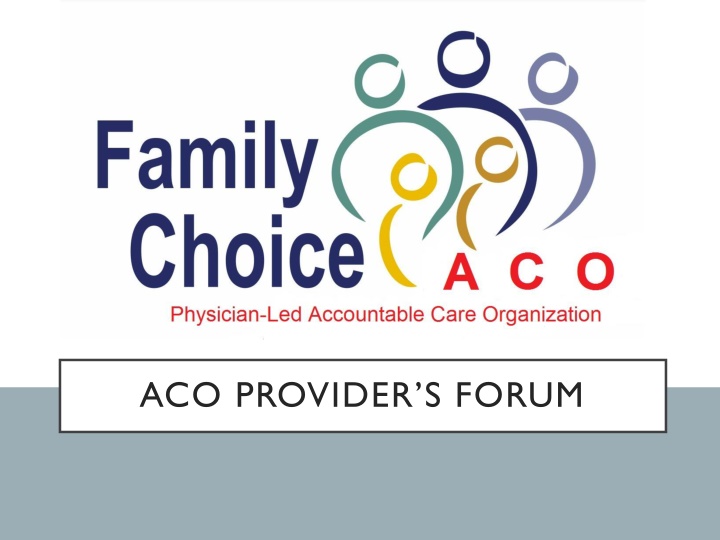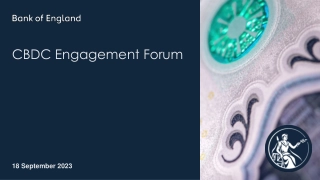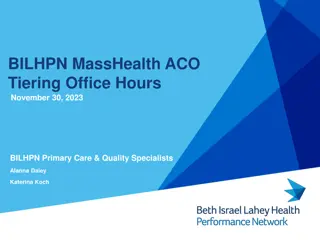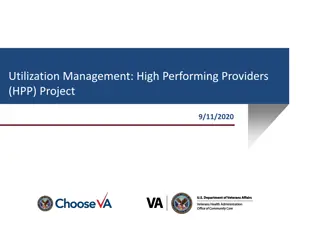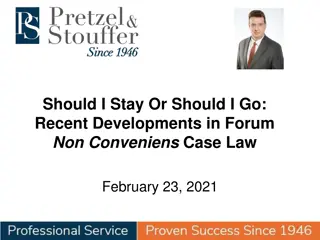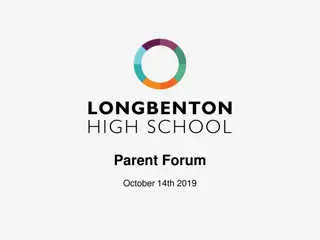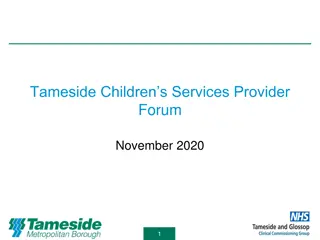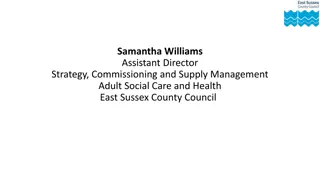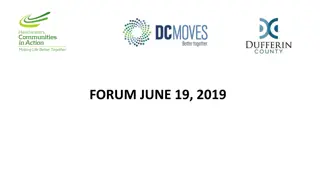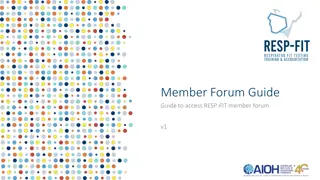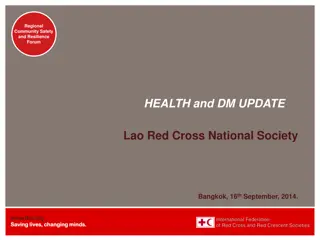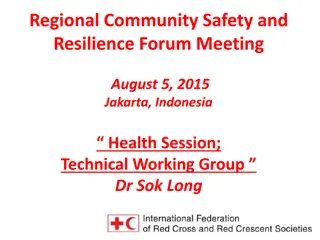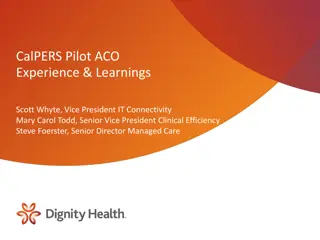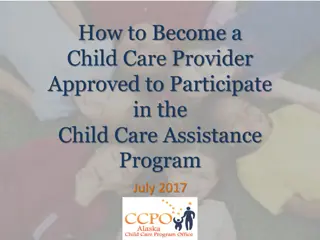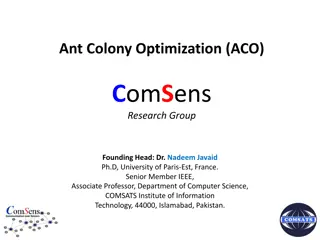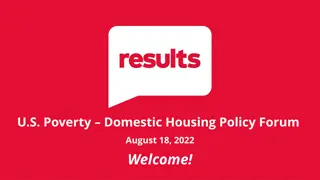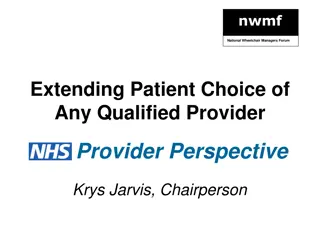ACO Providers Forum Agenda
Updates, plans, and programs discussed at the ACO Provider's Forum, including shared savings, quality care, documentation, and more. Get insights into improving care quality and closing gaps in healthcare services.
Download Presentation

Please find below an Image/Link to download the presentation.
The content on the website is provided AS IS for your information and personal use only. It may not be sold, licensed, or shared on other websites without obtaining consent from the author.If you encounter any issues during the download, it is possible that the publisher has removed the file from their server.
You are allowed to download the files provided on this website for personal or commercial use, subject to the condition that they are used lawfully. All files are the property of their respective owners.
The content on the website is provided AS IS for your information and personal use only. It may not be sold, licensed, or shared on other websites without obtaining consent from the author.
E N D
Presentation Transcript
AGENDA 1. ACO Year to Date General Updates (2020 and Beyond) 2. Review of 2020 Shared Savings Distribution Plan 3. 2020 Quality Care Gap Plan/Reports 4. ACO Quality Measures 5. Provider Documentation Request 6. Cozeva Access for ACO Providers 7. 2020 ACO Hospitalist Program 8. ACO Chronic Care Management Program
ACO YEAR-TO-DATE GENERAL UPDATES (2020 AND BEYOND)
FCACO Performance Year 2020 Year three of existing contract Approximately 12K aligned patients Due to Covid-19, CMS to grant one-year extension
FCACO Continue the momentum from 2019 action plan focusing on closing quality gaps in care and HCC coding FCACO to distribute monthly chase lists/reports customized to each PCP practice to prioritize and streamline workload and achieve results Goal to achieve an increase in 2019 scores and positive surplus by year end
REVIEW OF 2020 SHARED SAVINGS DISTRIBUTION PLAN
FCACO Performance Year 2020 Three-part shared savings plan HCC coding recapture Quality performance ACO program participation CCM opt in CCM In-house billing opt-in ACO Hospitalist opt-in
2020 QUALITY CARE GAP PLAN/REPORTS
FCACO Continue the momentum from 2019 action plan focusing on closing quality gaps in care and HCC coding FCACO to distribute monthly chase lists/reports customized to each PCP practice to prioritize and streamline workload and achieve results Goal to achieve an increase in 2019 scores and positive surplus by year end
ACO QUALITY MEASURES
Getting Timely Care, Appointments and Information How Well Providers Communicate CAPHS SURVEY Care Coordination Courteous and Helpful Office Staff
Patients Rating of Provider Access to Specialists CAPHS SURVEY Health Promotion and Education Shared Decision Making
Health Status/Functional Status Between Visit Communication CAPHS SURVEY Helping You to Take Medication as Directed Stewardship of Patient Resources
FAMILY CHOICE ACO QUALITY MEASURE SPECIFICATIONS 2019 Quality Reporting Measure Performance
SCREENING FOR FUTURE FALL RISK Description Codes CPT: 1101F (0-1 falls) CPT: 1100F (2+ fallsor any fall w/injury) Patients 65+ who were screened for future fall risk during the measurementperiod. Exception: medical reason(s) (i.e pt notambulatory) Documentationrequirements? Documentation of whether the patient has been assessed for a history of falls or any fall with injury. Documentation of no falls is sufficient. Gait or balance assessment meets the intent of the measure Documentation of the reason why the Quality Action is not performed due to an exception
DM: HEMOGLOBIN A1C POOR CONTROL Description Codes ICD-10 (Diabetes):Ell. Patients 18 75 years of age with diabetes who had hemoglobin A1c >9.0% during the measurement period. CPT: 3046F (most recent HbA1c>9.0%) Documentation requirements? Adiagnosis of diabetes;and The date and value of the most recent HbA1ctest. Note: This is an inverse measure where a lower score indicates betterquality
HTN: CONTROLLING HIGH BLOOD PRESSURE Description Codes CPT: G8752(Systolic BP<140mmHg) CPT: G8754 (Diastolic BP<90mmHg) Patients 18 85 years of age who had a dx of HTNand whose blood pressure was adequately controlled (<140/90 mmHg) during the measurementperiod. Exclusions: Dialysis or renal transplant before orduring the measurement period; ESRD; Pregnancy during the measurementperiod Documentationrequirements? A diagnosis of essential HTN within the first six months of the measurement period or any time prior to the measurement period but does not end before the start of the measurement period The date and value of the most recent systolic and diastolic blood pressure readings.
DEPRESSION REMISSION AT 12 MONTHS Description Codes ICD-10 (MajorDepression): F33. ICD-10 (Dysthymia):F34.1 CPT: G9509 (remission at 12 months) Patients 18+ with Major Depression or Dysthymia and an initial PHQ-9 score > 9 who demonstrate remission at twelve months defined as PHQ-9 <5. This measure applies to patients with newly diagnosed and existing depression whose current PHQ-9 score indicates a need for treatment. Exclusions: Permanent nursing home residents oractive diagnosis of bipolar or personalitydisorder Documentationrequirements? A diagnosis of Major Depression or Dysthymia; and A PHQ-9 score >9 between 12/1/2016 and 11/30/2017;and A follow-up PHQ-9 score < 5 at 12 months (+/- 30 days) after the initial PHQ-9 score > 9. If there is more than onePHQ-9 score obtained between the 11 and 13 month window, select the most recent PHQ-9 date and score within that window; or Documentation of exclusion criteria
BREAST CANCER SCREENING Description Codes CPT: 3014F (results documented & reviewed) Women 50-74 years of age who had a mammogram to screen for breast cancer during the measurement period or 15 months prior to the measurement period (10/1/16-12/31/18). Exclusions: Bilateral mastectomy or evidence of two unilateralmastectomies Documentationrequirements? Date the mammogram was performed and the results; or Documentation of exclusion criteria. Note: The measure steward has clarified that documentation of abnormal or normal results is considered sufficient documentation of mammography results.
COLORECTAL CANCER SCREENING Description Codes CPT: 3017F (screening results documented & reviewed) Patients 50-75 years of age who had appropriate screening for colorectal cancer. Exclusions: A diagnosis or past history of totalcolectomyor colorectal cancer The following are appropriate colorectalcancerscreenings: Fecal occult blood test (FOBT)duringthe measurementperiod Flexible sigmoidoscopy during the measurement period or 4 years prior to themeasurementperiod Colonoscopy during the measurement period or 9 years prior to themeasurementperiod CT colonography during the measurement period or the 4 years prior to themeasurementperiod Fecal Immunochemical DNA test (FIT-DNA) during the measurement period or 2 years prior tothe measurement period Documentation requirements? Indication of a current colorectal cancer screening, as evidenced by thecompletion of one of the tests or procedures within its corresponding timeframe and must indicate the date the screening was performed and the result; or Documentation of exclusioncriteria Note: The measure steward has clarified that documentation of abnormal or normal results is considered sufficient documentation of mammography results.
INFLUENZA IMMUNIZATION Description Codes CPT: (Influenza administered previously received) G8482 vaccine Patients aged 6 months+ seen for a visit between October 1 and March 31 who received an influenza immunization OR who reported previous receipt of an influenza immunization. Exceptions: medical reason(s) (i.e. allergy, intolerance); patient reason(s) (i.e. pt declined) system reason(s) (i.e. lack of vaccine availability) or Documentationrequirements? Documentation that the patient received an influenza immunization between August 1, 2017 and March 31, 2018; or Documentation of the reason why the Quality Action is not performed to an exception.
TOBACCO USE: SCREENING AND CESSATION Description Codes CPT: 4004F (screened for tobacco use & received cessation intervention) CPT: 1036F (currenttobacco non-user) Patients aged 18+ who were screened for tobacco use at least once within 24 months. For any patient identified as a tobacco user, tobacco cessation intervention must also be provided. Tobacco use includes any type of tobacco. Exceptions: medical reason(s) (i.e. limited life expectancy) Documentation requirements? The date and results of a query of the patient s use of tobacco If identified as a tobacco user, documentation of tobacco cessation intervention; or Documentation of the reason why the Quality Action is not performed due to an exception Note: Screening for tobacco use and cessation do not have to occur on the same encounter, but must occur during the 24-month look-back period The USPSTF does not currently classify ENDS (electronic nicotine delivery systems) as tobacco use or as a cessationaid.
SCREENING FOR CLINICAL DEPRESSION AND FOLLOW-UP PLAN Description Codes CPT: G8431 (positive screen & f/u plandocumented) CPT: G8510 (negative screen documented, f/u plan not required) Patients aged 12+ screened for depression on the date of the encounter using an age appropriate standardized depression screeningtoolAND if positive,a follow-up plan is documented on the date of the positivescreen Exclusion: Activediagnosis for depressionor bipolardisorder Exceptions: medical reason(s) A follow-up plan for a positive screen must contain one or more of thefollowing: Additional evaluation for depression Suicide risk assessment Referral to a practitioner who is qualified to dx and tx depression Pharmacological interventions Other interventions or follow-up for the dx or tx of depression What are the documentation requirements? The date and results of a named age appropriate standardized depression screening tool If a follow-up plan is required, documentation of discussion of the plan must be included. The follow-up plan mustbe specified as an intervention that pertains to depression; or Documentation of the reason why the Quality Action is not performed due to an exception orexclusion.
PRESCRIPTION FOR STATIN THERAPY Codes Description CPT: G9664 (current statin therapy users or received a prescription for statin therapy) Percentage of the following patients all considered at high risk of CV events who were prescribed or were on statin therapy during the measurement period: Adults 21+ previously diagnosed with or currently have an active diagnosis of clinical atherosclerotic cardiovascular disease (ASCVD); or Adults 21+ who ever had a fasting or direct low-density lipoprotein cholesterol (LDL-C) level >=190mg/dL or previously diagnosed with or currently have an active diagnosis of familial or pure hypercholesterolemia; or Adults 40-75 years with diagnosis of diabetes with fasting or direct LDL-C level of 70-189mg/dL Exclusion: Pregnancy, breastfeeding or rhabdomyolysis Exceptions: medical reason(s) Documentation requirements? Active diagnosis of clinical ASCVD; or Fasting or direct low-density lipoprotein cholesterol (LDL-C) level greater than or equal to 190mg/dL (any time in patient s history, but prior to end of the measurement period); and Active prescription for statin therapy anytime during measurement period; or Documentation of the reason why the Quality Action is not performed due to an exception or exclusion criteria
PROVIDER DOCUMENTATION REQUEST
FCACO Return members demographic list Provide timely access to chart evidence Provide annual wellness checkup and progress notes Participation in FC ACO hospitalist program
PROVIDER DOCUMENTATION REQUEST (SAMPLE)
COZEVA ACCESS FOR ACO PROVIDERS
FCACO Providers participating in ACO will be granted access to the ACO quality, HCC and CCM population health system How to Close Gaps in Care - FCACO will provide training and provider assistance ACO providers are asked to use Cozeva to address open care gaps Identify HCC opportunities and submit documentation
HOSPITALIST PROGRAM Why it is important to join FC ACO hospitalist program? Better care coordination & efficiency Divert unnecessary hospitalizations Shared savings will go back to ACO physicians
BACKGROUND The FCHN hospitalist program has contributed greatly to the overall success of Family Choice Health Network A part of that success can be attributed to the need to manage inpatient care at just one hospital Fountain Valley Regional Hospital (FVRH) However, changes to the healthcare environment are driving FCHN to expand outside of FVRH The ACO program allows Seniors to access a wide choice of hospitals The Newsom administration is forcing networks to have county-wide access for MediCal members Opportunities for growth in OC are located too distant from FVRH
ENHANCING THE FCHN HOSPITALIST PROGRAM A re-structuring of the hospitalist program is needed to keep pace with the changing healthcare environment Expanded to cover a network of hospitals strategically located to: Blanket the county geographically Cover hospitals that beneficiaries self-select
ENHANCING THE FCHN HOSPITALIST PROGRAM (CONT.) Not only focused on reducing Length of Stay (LOS) but additionally: Working across the spectrum of non-office care: SNF, home health, hospice Diverting marginal admissions to SNF and home settings with PCP/specialty follow-up Responding rapidly to ED requests for evaluation which allows time for diversion Taking responsibility for ensuring appropriate transition of care (TOC) to reduce 30-day readmission rates Viewed as working across all product lines: ACO, MediCal, Medicare Advantage, Commercial Restructuring will include both organizational and financial aspects
ORGANIZATIONAL CHANGES The Board of Directors is taking a more active role in management of the hospitalist program Dr. Alan Tran, Chief Medical Officer (CMO) of FCHN, will oversee the clinical quality of the program Dr. Dillon Tran, Chief Operating Officer (COO) of FCHN, will ensure that the Coordination of Care is optimized Dr. Lowell Gordon, Medical Director of FCHN, will continue to be the day-to-day contact for trouble-shooting problems that arise The commitment of resources at the Board level underscores the continuing and increased importance of the hospitalist program to the success of FCHN
ORGANIZATIONAL CHANGES (CONT.) PCPs are being asked to commit to using the FCHN hospitalist program for all product lines Allows for the creation of a single call schedule Reduces confusion at the hospital Strengthens the relationship with ED physicians whose cooperation is critical to program success FCHN has partnered with 24/7 to effect a coordinated TOC program that ensures timely response and maximal communication throughout the network A monthly call schedule will be published to enhance coordination and accountability
FINANCIAL CHANGES To recognize the importance of the hospitalist program to the overall success of FCHN: The physicians serving as hospitalists will be entitled to earn merit- based incentives along with PCPs and Specialists A hospitalist cost center will be created to measure financial performance Successful diversions from inpatient admission to alternative settings of care will be tracked and recognized Feedback on readmission rates will become a standard metric for Board quality reporting A successful hospitalist program will continue to enhance FCHN s standing among payors and government agencies
ACO CHRONIC CARE MANAGEMENT PROGRAM
ACO & CHRONIC CARE MANAGEMENT PROGRAM Providers must opt in and sign participation and in-house billing addendum FCACO will no longer support offices that elect self billing as of 9/1/2020 to reduce administrative burden CCM participation will increase shared savings payout opportunity
ACO & CHRONIC CARE MANAGEMENT PROGRAM Chronic Care Management 209+ providers enrolled 5000+ patients Staffing includes 6 fulltime care coordinator/data analysts located at corporate offices More than $51,000+ has been distributed.
ACO & CHRONIC CARE MANAGEMENT PROGRAM CMS has made care management reimbursable, but it requires a care team to effect: No face-to- face visit CCM activities include: Post hospitalization discharge planning and follow up Medication reconciliation Coordinating care among specialists Sharing of ancillary test results Managing length of stay in both hospital and Skilled Nursing
ACO & CHRONIC CARE MANAGEMENT PROGRAM CCM activities include: Engaging families and determining care expectations and goals Working with ER physicians and hospitalists to determine optimal care setting Coordinating with home and community-based services Facilitating appointments and accessing care as recommended 24/7 access to address urgent needs/care coordination
PCP CCM BILLING/DOCUMENTATION In-house Billing ACO will bill Medicare directly for monthly CCMS services Provider with get a monthly payment each patient who has met the 20-minute time aggregated threshold
PCP CCM BILLING/DOCUMENTATION 99490 (20 minutes or more) Only one practitioner bills/allowed Time aggregated/documented/collected from different per 30 calendar days 99487 (60 minutes/month) 99489 (additional 30 mins., max 90 min)
ONE-YEAR OFFICE ALLY SUBSCRIPTION Family Choice will pay one year of Office Ally subscription for those who move from paper chart to EMR (certain criteria applied) Please contact FCACO for more information.
